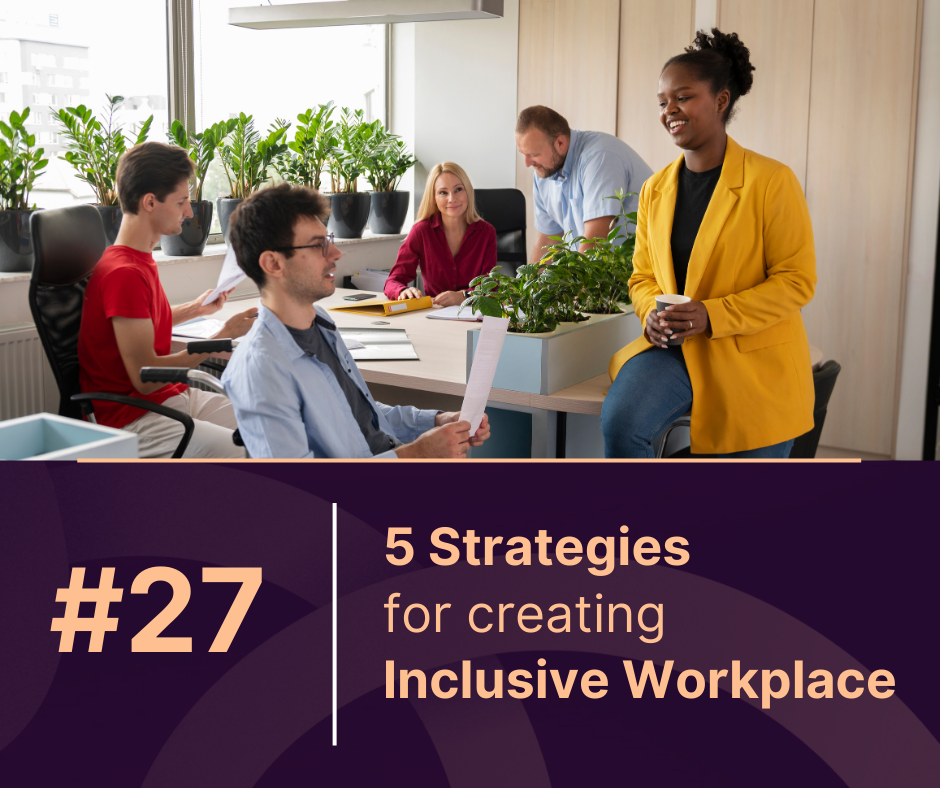Creating an inclusive workplace isn’t just about fulfilling obligations or ticking off boxes on a diversity checklist—it’s about cultivating an environment where every individual feels valued, respected, and empowered to contribute to the organization’s success. Inclusivity goes beyond diversity; it’s the practice of ensuring that everyone, regardless of their background, feels they belong. This article explores five key strategies for fostering an inclusive workplace that helps both employees and the organization thrive.
1. Foster Open Communication
At the core of an inclusive workplace is open communication. Ensuring that everyone, regardless of their role or background, has a voice helps build trust, encourages innovation, and improves team dynamics. Communication should flow in all directions—upward, downward, and laterally.
How to implement:
- Encourage Feedback: Actively solicit feedback from all levels of employees. Use anonymous surveys, one-on-one check-ins, and team meetings to gather insights about how people feel within the organization.
- Create Safe Spaces: Encourage a culture where people feel safe to voice their concerns or ideas without fear of reprisal or being dismissed. Leadership needs to actively demonstrate that constructive criticism is valued and leads to action.
- Listen Actively: Listening is just as important as speaking. Train managers and team leaders to engage in active listening, ensuring that employees feel heard and understood.
When employees know their voices matter, they are more likely to contribute unique perspectives, which benefits everyone in the workplace. Open communication fosters a sense of belonging, making inclusivity a natural part of the work culture.
2. Implement Unconscious Bias Training
Unconscious bias can unintentionally influence decisions in hiring, promotions, and even day-to-day interactions. To combat this, organizations need to acknowledge the existence of these biases and take steps to address them.
How to implement:
- Conduct Regular Training: Make unconscious bias training a mandatory and ongoing part of professional development. This training helps employees identify and mitigate biases they may not even be aware of.
- Monitor Progress: Assess whether the training is making a real difference by tracking key diversity and inclusion metrics. This could include monitoring hiring, promotion, and attrition rates for underrepresented groups.
- Encourage Self-Reflection: Encourage employees to engage in personal reflection and discussion around bias. Providing opportunities for employees to question and challenge their assumptions can lead to greater awareness and action.
Training employees to recognize unconscious bias helps create a more level playing field, reducing discrimination and fostering a more inclusive environment.
3. Encourage Diversity in Leadership
An inclusive workplace is one where leadership reflects the diversity of the wider organization. A diverse leadership team ensures that a range of perspectives is considered when making important decisions, which leads to better outcomes for the business and its employees.
How to implement:
- Promote from Within: Identify and nurture potential leaders from diverse backgrounds. Ensure that your leadership pipeline includes candidates from underrepresented groups.
- Mentorship Programs: Set up mentorship programs where senior leaders can mentor employees from different backgrounds, helping to build their confidence, skills, and leadership potential.
- Inclusive Leadership Training: Equip current leaders with the skills to manage diverse teams effectively. Inclusive leadership requires emotional intelligence, empathy, and an understanding of how different backgrounds and experiences can shape team dynamics.
Diverse leadership sends a powerful message: inclusivity is not just a goal, it’s a priority. When employees see representation at the top, it builds a sense of belonging and motivates them to contribute more actively.
4. Create Employee Resource Groups (ERGs)
Employee Resource Groups (ERGs) are voluntary, employee-led groups formed around common interests, backgrounds, or demographics. ERGs can play a critical role in fostering an inclusive workplace by providing a safe space for individuals to connect, share experiences, and advocate for positive change.
How to implement:
- Provide Resources: Offer the necessary resources, such as meeting spaces, budgets, and leadership support, to help ERGs flourish. This demonstrates the organization’s commitment to inclusivity.
- Encourage Cross-Participation: While ERGs may form around specific identities, encourage employees from all backgrounds to participate. This promotes understanding and empathy across different groups.
- Support ERG-Led Initiatives: Allow ERGs to lead initiatives, such as awareness campaigns or cultural celebrations, which can educate the broader workforce and promote inclusivity.
ERGs give employees a sense of community within the workplace and provide a platform for underrepresented voices. They also contribute to an environment where everyone feels seen and supported.
5. Offer Flexible Work Arrangements
Inclusivity also involves accommodating the diverse needs of employees, including their work-life balance. Offering flexible work arrangements can make a significant difference for employees who have unique personal responsibilities, whether it’s caregiving, health concerns, or pursuing educational goals.
How to implement:
- Introduce Flexibility in Schedules: Allow employees to have flexible start and end times or to work remotely when possible. This is particularly beneficial for parents, caregivers, and individuals with disabilities.
- Promote Work-Life Balance: Encourage employees to take advantage of flexible work policies without fear of stigma or penalty. This can be done through clear communication from leadership and setting a positive example.
- Consider Customized Solutions: Offer tailored solutions for employees with specific needs, such as additional leave for new parents or accommodations for employees with disabilities.
Providing flexibility demonstrates an understanding that employees have lives outside of work, and when they feel supported, they’re more engaged and productive.
Conclusion
Building an inclusive workplace requires intentional action, commitment from leadership, and continuous improvement. By fostering open communication, implementing unconscious bias training, encouraging diversity in leadership, supporting Employee Resource Groups, and offering flexible work arrangements, organizations can create an environment where everyone feels valued and empowered to succeed. These strategies will not only make your workplace more inclusive but will also lead to higher employee satisfaction, improved retention, and better overall performance.
Inclusion isn’t a destination; it’s a journey. By consistently evaluating and refining these strategies, your organization can lead the way in creating a workplace where everyone, regardless of their background, has the opportunity to thrive.
Questions:
1. Why is open communication important for creating an inclusive workplace?
Open communication is essential because it builds trust, encourages innovation, and improves team dynamics. When employees feel their voices are heard, regardless of their background or role, it fosters a sense of belonging. Open communication helps everyone contribute unique perspectives, which benefits the entire organization.
2. How can unconscious bias training help in fostering an inclusive work environment?
Unconscious bias training helps employees recognize and address hidden biases that can influence hiring, promotions, and daily interactions. By conducting regular training and encouraging self-reflection, organizations can reduce discrimination and create a more level playing field for all employees, improving overall inclusivity.
3. What role does diverse leadership play in creating an inclusive workplace?
Diverse leadership ensures that a range of perspectives is considered when making decisions. This leads to better business outcomes and demonstrates that inclusivity is a priority. A leadership team that reflects the diversity of the workforce motivates employees and fosters a sense of belonging within the organization.
4. What are Employee Resource Groups (ERGs), and how do they contribute to workplace inclusivity?
Employee Resource Groups (ERGs) are voluntary, employee-led groups formed around shared interests or demographics. They provide a safe space for employees to connect, share experiences, and advocate for positive change. ERGs promote inclusivity by creating a sense of community and providing platforms for underrepresented voices within the organization.
5. Why are flexible work arrangements important for promoting inclusivity?
Flexible work arrangements accommodate employees with diverse needs, such as caregiving responsibilities, health concerns, or educational goals. Offering flexible schedules or remote work options allows employees to manage their work-life balance effectively, fostering a supportive and inclusive work environment.
6. How can organizations implement diversity in leadership effectively?
Organizations can promote diversity in leadership by identifying and nurturing leaders from underrepresented backgrounds, implementing mentorship programs, and offering inclusive leadership training. These efforts ensure that diverse talent is recognized, developed, and represented in leadership positions, reinforcing inclusivity at all levels of the organization.
7. What are some ways to encourage participation in Employee Resource Groups (ERGs)?
To encourage participation in ERGs, organizations can provide resources such as meeting spaces, budgets, and leadership support. They can also promote cross-participation, inviting employees from all backgrounds to join, and support ERG-led initiatives, such as awareness campaigns or cultural celebrations, to educate the broader workforce on inclusivity.



